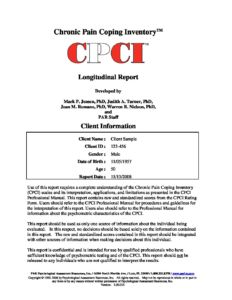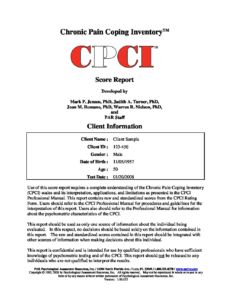
Chronic Pain Coping Inventory cpci
For: Assess patients' pain coping strategies
Reading Level: Adult, Elder Adult
Format: Paper-and-Pencil
Length: 10-15 Minutes
Online Forms, Reports, Kits & e-Manuals
All online resources including Forms, Reports, i-Admins, Kits and e-Manuals.
CPCI online Longitudinal Score Report (each) min order 5
CPCI online Score Report (each) min order 5
CPCI online i-Admin (each) min order 5
Author
Mark P. Jensen, PhD, Judith A. Turner, PhD, Joan M. Romano, PhD and Warren R. Nielson, PhD
Description
Designed to assess the use of coping strategies that are typically targeted for change in multi-disciplinary pain treatment programs, the CPCI addresses several shortcomings of existing measures, including the lack of behavioural-strategy assessment. It is a 70-item self-report instrument on which the individual is asked to indicate the number of days during the past week he/she used the listed coping strategy to deal with his/her pain. This newly standardised version of the CPCI was normed using a sample of 527 patients with chronic pain. The CPCI was designed to assist numerous health care providers, including psychologists, physicians, psychiatrists, clinical social workers, occupational therapists, and physical therapists, as well as other mental health and health care providers working with adults aged between 21-80 years.
The CPCI assesses pain coping strategies that have been identified as contributors to the adjustments a patient makes to chronic pain.
The CPCI can be used in a variety of testing situations, including:
pre-treatment screening to determine treatment necessity;
pre-treatment and post-treatment to determine treatment effectiveness; and
periodic re-evaluations to document treatment progress.
The CPCI consists of nine scales that are divided into two domains -the Illness-Focused Coping Domain and the Wellness-Focused Coping Domain.
Illness-Focused Coping Domain
Guarding Scale -Assesses the extent to which a patient reports restricting the use/movement of a body part as a way of coping with pain.
Resting Scale -Assesses the extent to which a patient uses pain-contingent rest (e.g. lying down) as a way to cope with pain.
Asking for Assistance Scale -Assesses the frequency with which a patient asks someone (e.g. a family member) for help with a chore when he/she is in pain.
Wellness-Focused Coping Domain
Exercise/Stretch Scale -Assesses how many days per week a patient stretches various muscle groups, engages in various muscle strengthening exercises and engages in aerobic exercise for at least 15 minutes.
Relaxation Scale -Assesses the frequency with which a patient uses strategies (e.g. imagery, listening to music, meditation, self-hypnosis) to experience relaxation.
Task Persistence Scale -Assesses the extent to which a patient continues normal activity despite his/her pain.
Coping Self-Statements Scale -Assesses the frequency with which a patient purposefully uses adaptive cognitions when he/she experiences pain.
Pacing Scale -Assesses the extent to which a patient is able to conduct activities in a paced, steady manner that is not contingent on pain.
Seeking Social Support Scale -Assesses the frequency with which a patient seeks out a friend/loved one for companionship and support when in pain.
Features
Standardised on a sample of 527 chronic pain patients.
T scores and percentiles are included for calculating scores.
Reliable Change scores are included to assist in determining if there are differences between scores obtained on two different testing occasions (e.g. pre-treatment vs. post-treatment).
Interpretive guidelines and case examples are included.
Profile Form includes a skyline for clinically elevated scores and treatment goals.
Reliability and Validity
Median internal consistency for the nine CPCI scales ranges from .70 to .94 for the four sub-samples of chronic pain patients that compose the standardisation sample.
Corrected correlations for the test-retest stability of the CPCI scales range from .55 to .84.
The validity of the CPCI is discussed in terms of evidence based on intercorrelations among the CPCI scales, factor analysis of the CPCI, correlational analyses examining the relationships between the CPCI scores and scores on related measures (i.e. coping, mental health/psychological functioning, physical dysfunction/disability, stages of change, pain attitudes/beliefs), and the use of the CPCI as a measure of treatment outcome.
NB: Prices are in Australian dollars inclusive of GST. NZ customers need to log in to view ex-GST prices.





